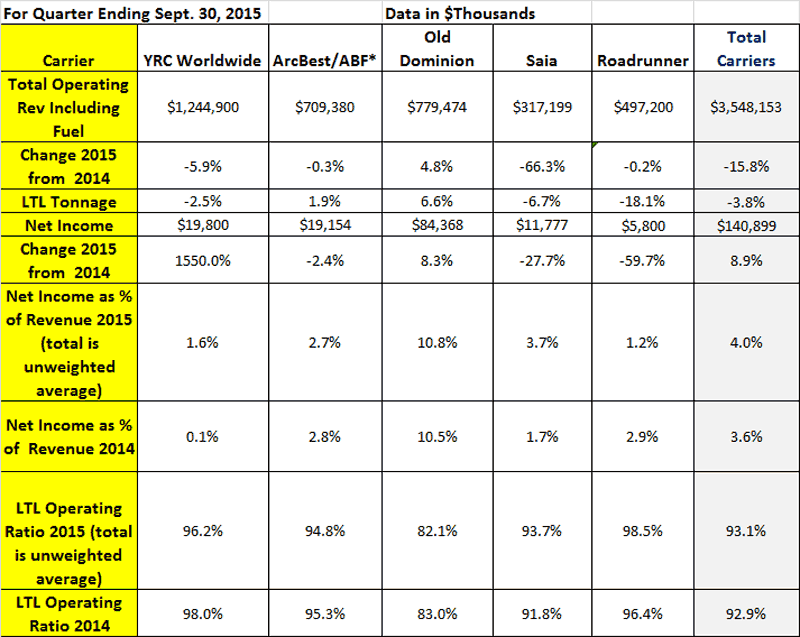From SCDigest's On-Target E-Magazine
- Nov. 23, 2015-
Supply Chain News: US LTL Carriers have Mixed Results in Q3, but Old Dominion Powers On
Despite Soft Volumes, Rates Up Strong in Q3, as Old Dominion Continues to Far Outperform
SCDigest Editorial Staff
Consistent with results from truckload and rail carriers, US less-than-truckload (LTL) carriers said they saw weak freight volumes in Q3, but were nonetheless able to keep rates heading much higher, even as profits were tough to come by for all but - who else - Old Dominion.
SCDigest Says: |
 Despite weak volumes, at YRC Freight, for example, revenue per hundredweight - a proxy for freight rates - increased by 5.8% in the quarter. Despite weak volumes, at YRC Freight, for example, revenue per hundredweight - a proxy for freight rates - increased by 5.8% in the quarter. |
| |
|
What Do You Say?
|
|
|
|
We're back as usual every quarter with our review of the results and trends across freight modes. We started with US truckload carriers carriers (see US Truckload Carriers Enjoy Generally Strong Q3, Finally Starting to Add Capacity) and then last week we covered the US rail sector (see Rail Carriers See Volumes Drop in Q3, but Rates, Profits Again Stay Strong.)
The results were quite similar across both those sectors: characterization of the Q3 freight environment as lukewarm or even weak, but still more than decent financial results achieved on the back of a strong rate environment despite the tepid volumes.
This week, it's time for a look at the LTL sector and the (adjusted) five public
carriers we follow. We'll note that does not include two of the largest
LTL providers - UPS and FedEx - because neither UPS nor FedEx breaks out
their numbers in a way that allows the LTL portion to be isolated out
from other freight business such as truckload carriage (FedEx) and
supply chain services (UPS).
In addition, XPO Logistics' acquisition of Conway Freight, one of the US' largest LTL carriers, closed in late October. That means we had to replace Conway in our review, pending on how XPO breaks out its LTL results in subsequent quarters. Conway is replaced in our analysis here by Roadrunner Transport, which has a significant LTL business.
Overall, the story was much the same as for truckload and rail. Freight volumes were reported as "weaker than expected" by ArcBest/ABF Freight, and "soft" by Roadrunner. In an unweighted average, tonnage was down 3.8% in Q3 across all five carriers in our pool, though that includes a substantial decrease of 18.1% at Roadrunner, driven by issues in its relationships with independent owner-operators.
But rates were apparently still up strongly despite those weak volumes. At YRC Freight, for example, revenue per hundredweight - a proxy for freight rates - increased by 5.8% in the quarter. ABF said excluding fuel surcharge, its revenue per hundredweight was up in the mid-single digit range, good for ABF but not for shippers.
What's more, several LTL carriers have recently announced general rate increases in the 5% range.
All told, profits for the group were up 8.9% in Q3, but that total masks the winners and losers. YRC saw net income of about $20 million - not much on over $1.2 billion in revenue in the quarter - but well up from basically break even results in Q3 2014.
Old Dominion as usual powered on, with net income up 8.3% in the quarter on a 6.6% rise in tonnage. The other three LTL carriers we follow saw declines in net income, but all were at least in the black.
The unweighted operating ratio average, or operating expense divided by operating revenue, a key transport sector metric, rose to 93.1%, up just a little from 92.9% in 2014.
However, that OR performance was as usual led by Old Dominion, with an operating ratio of 82.1%, down almost another percentage point from 2014. Excluding Old Dominion, the average OR from the group was 95.8%.
You'll find all that data and more in the table below.
LTL Sector Q3 2015 Operating Results

Source: SCDigest
(Transportation Management Article Continued Below)
|